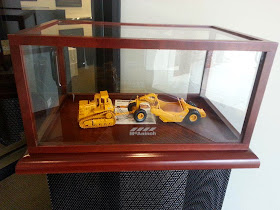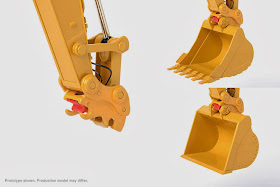Josh sent us a photo he took in the entryway of the McAninch corporate office. It's our D9L with towed 631E scraper. High praise indeed. Thanks, Josh!
Monday, January 27, 2014
Friday, January 24, 2014
1:24 scale Cat 336E L samples
We just got our samples of our 1:24 scale Cat 336E L Excavator in both Quick Coupler and Hydraulic Thumb versions. We are so excited, we just had to share!
Since this is still a tooling sample, there are quite a few changes and additions to be made. For example, hydraulic hoses and fittings will be modified, teeth on the thumb will mesh with the bucket, and tampo markings will be added.
We even included a size comparison with our 1:48 scale D9L so you can see just how huge this model really is. It weighs nearly ten pounds. Enjoy!
Thursday, January 16, 2014
CCM will be at CONEXPO-CON/AGG
Classic Construction Models will be at CONEXPO-CON/AGG, March 4-8, 2014, in Las Vegas!
We are very excited to be among the exhibitors at this incredible construction industry event that only happens once every three years. The display of full-size cranes, tractors, and equipment is among the best in the world, and includes manufacturers that support earthmoving, lifting, mining, and utilities.
We will have current and upcoming models of ours on display, as well as a few surprises! Meeting our collectors is always a huge thrill for us. So, come by and say hello to our crew.
We will be in Gold Hall, booth 70141, right next to Allied Power Products Inc.
Learn more about CONEXPO-CON/AGG here at their website. See you in Vegas!
Thursday, January 9, 2014
Custom Spotlight: Markus Jaksch
Occasionally we post images of the modifications our customers give to their CCM models in the Customer Highlights section of our website. Whether clean and new or rusty and worn, we love to see the modifications, super-detailing and custom painting people come up with for our models. With so many recent submissions, we have been inspired to start a new feature where we look more closely at some of this great work.
Our first featured customizer is Markus Jaksch. When you first look at his custom detailed CCM models you might need a second take to make sure it's not a real machine. He has a love for old Caterpillar equipment, that's for sure, but he doesn't want them showroom fresh. Rather, he prefers to add a few years to the appearance of these old workhorses so they look like they've spent decades digging and moving dirt.
Here we see Markus' work on our Cat 245 Front Shovel and 769 Rear Dump Truck. We think you will agree the images speak for themselves.
The rust, the flaking paint, the scrapes and dents—all are are done with a patient hand utilizing a time-consuming process. Markus starts the magic by first removing the original paint from the model and applying a new primer of a special rust colored liquid. After this is dry, a very thin coat of new paint is added, then the rust stains are applied over this with a needle and custom brushes. The finish is further brought out with dry pigments and other "special methods". The final touch is photographing the models in hand-crafted scale backgrounds with natural light. As you can see, the results are stunning!
When it comes to advice for others who wish to try this technique for customizing their own models, Markus replies, "Practice, practice...and (start with) very well done models, models from CCM."
According to Markus, other models of ours are waiting to go through his custom aging process but they have to stay "top secret" for now. We here at CCM extend our sincere thanks to him for sharing his photos with us, and we can't wait to see what's next!
Tuesday, January 7, 2014
CCM Behind the Scenes: Diecast vs. Brass
Although many collectors know there is a difference in the alloys used to make brass and die-cast models the differences in the processes of making these two types of models is sometimes subtle and sometimes drastic.
When Classic Construction Models opened for business almost 25 years ago, its founder Bob Peterson, was an aficionado of vintage toys and models, including highly-detailed brass model locomotives. These replicas, outside of the running gear, were made of cast, etched and sheet formed brass. Its strength, malleability, ability to capture small details when cast and ease of joining allowed for the creation of models that approach being part-for-part recreations of an actual machine. These attributes were a key part of why our first model was made from brass.
Die casting has been used to make toys and miniatures for almost a hundred years. The basic process of forcing molten metal under pressure into a mold cavity made of hardened steel has remained relatively constant while the process of making the dies is the beneficiary of numerous high tech changes that have improved the ability to capture details. As the upfront cost of tooling is extremely expensive it is practical for only long production runs that allow the cost to be amortized over a large number of models.
When creating a model in either material, the driving factor is the level of detail in the drawings provided by the designer to the manufacturer. Simply stated, a model is never better than the drawings from which it is created. With the advent of 3D drafting, it has become easier to share designs but again, poor drawings equal poor models.
From the drawings, the next step for every model is a hand sample, and it is this hand sample that guides the process of making molds for a die cast model or the components that will be cast, etched and formed for a brass model. For a brass model, making the parts is a laborious one-at-a-time process as they are literally made piece-by-piece. Given the qualities of brass, there are virtually no limitations as to design features and duplicating the original construction of a machine with sheet metal for sheet metal, castings for castings, and machined parts when appropriate.
For a die-cast model, the parts can be made faster in higher volume but because of the limitations of injection molding, with less detail. This means the designer must allow for “draft” so parts can be removed from a mold, as well as maintaining minimum thicknesses and part sizes. An example of where this is apparent is with cab walls and engine covers that will always be thick and bulky compared to a brass part. It’s also important to note that brass itself is far more expensive than the aluminum and zinc alloy used for die casting, so the cost per “finished pound” will always be higher.
Our first scale model, the Manitowoc 4100 Crawler Crane, was constructed of brass for a number of reasons – the most important being high detail and a small production run. This model was a game changer for construction model collectors as making it from brass allowed for details such as movable metal tracks – not “rubber bands” as found on other models - and a lattice boom that looked more realistic than anything previously offered. Given the information for its construction was transmitted virtually all by fax, it’s a testimony to the level of effort required to produce it.
We released our first die-cast construction model in 1995, and we have been pushing the envelope in this arena ever since. With features such as a finely detailed grill, accurate cab interior and individually-linked metal tracks it was declared “the best die-cast construction model ever” when it was introduced. As the industry has grown those features are now expected by collectors in every model they purchase. We are proud to be part of introducing more detail and accuracy that collectors now demand.
CCM will continue to make both brass and die-cast models as each has its own qualities and features for collectors. Just in case there was ever any doubt, we will also continue our quest to make the very best of both types.























